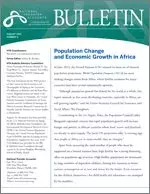Error message

Additional titles in the NTA Bulletin series In June 2013, the United Nations (UN) released its latest set of biennial population projections, World Population Prospects. One of the most striking changes comes from Africa, where fertility estimates for many countries have been revised substantially upwards. Apart from increasing the total number of people who must be supported on a limited resource base, high fertility has a strong distorting effect on population age structure. High-fertility populations are dominated by large numbers of dependent children, leaving few resources to boost current consumption or to save and invest for the future. In this situation, rapid fertility decline can lead to an immediate acceleration of economic growth, which has been termed the "first demographic dividend." Investment of the resources gained from this demographic jump-start can usher in a "second demographic dividend," providing the basis for sustained economic development. What does the future hold for Africa? In order to achieve a robust demographic dividend, policymakers in Africa's high-fertility countries need to focus first and foremost on fertility decline. The second policy priority is to increase investment in the health and education of children. All over the world, per capita investment in children has tended to increase as fertility goes down. It is important that African countries follow this path, both to assure the wellbeing of children today and to boost the productivity of the workforce tomorrow. Investments in children do not achieve a maximum economic impact, however, unless they are accompanied by a robust job market. If young adults can find productive employment, they will be able to enjoy higher consumption, invest in their own children, and set money aside for the future. In exploring alternatives for economic development, policymakers need to emphasize job growth for young workers. Finally, governments need to create an economic environment that helps working-age populations save and invest. Well-functioning financial markets, a strong banking system, secure property rights, a competitive economy, and financial literacy all play a role in assuring the economic security of all age groups.
|
Additional titles in the NTA Bulletin series In June 2013, the United Nations (UN) released its latest set of biennial population projections, World Population Prospects. One of the most striking changes comes from Africa, where fertility estimates for many countries have been revised substantially upwards. Apart from increasing the total number of people who must be supported on a limited resource base, high fertility has a strong distorting effect on population age structure. High-fertility populations are dominated by large numbers of dependent children, leaving few resources to boost current consumption or to save and invest for the future. In this situation, rapid fertility decline can lead to an immediate acceleration of economic growth, which has been termed the "first demographic dividend." Investment of the resources gained from this demographic jump-start can usher in a "second demographic dividend," providing the basis for sustained economic development. What does the future hold for Africa? In order to achieve a robust demographic dividend, policymakers in Africa's high-fertility countries need to focus first and foremost on fertility decline. The second policy priority is to increase investment in the health and education of children. All over the world, per capita investment in children has tended to increase as fertility goes down. It is important that African countries follow this path, both to assure the wellbeing of children today and to boost the productivity of the workforce tomorrow. Investments in children do not achieve a maximum economic impact, however, unless they are accompanied by a robust job market. If young adults can find productive employment, they will be able to enjoy higher consumption, invest in their own children, and set money aside for the future. In exploring alternatives for economic development, policymakers need to emphasize job growth for young workers. Finally, governments need to create an economic environment that helps working-age populations save and invest. Well-functioning financial markets, a strong banking system, secure property rights, a competitive economy, and financial literacy all play a role in assuring the economic security of all age groups.
|





